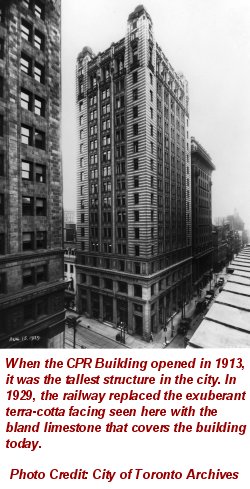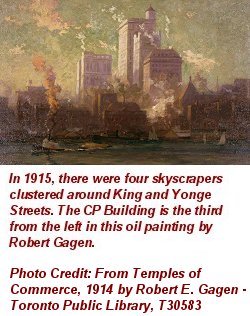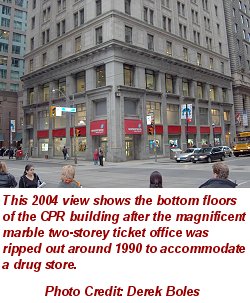




 |
The Canadian Pacific Building is located at 69 Yonge Street on the southeast corner of King and Yonge Streets in downtown Toronto. The edifice was built by the Canadian Pacific Railway Company, the largest privately owned railway in Canada. In the 1880s, the CPR built the first transcontinental railway for 3,000 miles between Montreal and British Columbia. The railway first began operating into Toronto in 1884 and built several stations within the city, including Don, North Toronto, West Toronto and Leaside.
By the early 20th century, the Canadian Pacific Railway was enjoying its greatest period of prosperity under the leadership of Sir Thomas Shaugnessy. All the railways maintained downtown ticket offices as a convenience for their customers so they wouldn't have to travel to Union Station to purchase their fares. The CPR also maintained corporate offices in several buildings throughout the city and wanted to consolidate them in one location in a new skyscraper at the corner of Yonge and King Streets, then the financial heart of Toronto and the most prestigious commercial district in the city. The Canadian Pacific Building was designed by the architectural firm of Darling & Pearson. John Pearson and Frank Darling would also be responsible for designing Convocation Hall at the University of Toronto, the CPR's North Toronto Station and the Royal Ontario Museum. John Pearson would later create a Canadian icon when he designed the Peace Tower in Ottawa, probably the most recognizable architectural structure in the nation, symbolizing Canada throughout the world. Construction on the CPR Building began in 1911 and it was completed in 1913. At 15 stories, it was the tallest building in the British Empire. The ground floor consisted of a grand two-story marble lobby and ticket office. Above the ticket lobby were various company offices including the CPR's lucrative telegraph operation. There was plenty of office space left over for the CPR to lease out to various businesses and professionals. The most striking feature of the building was that the entire structure from the third floor up was clad in a light cream semi-glazed terra cotta. By 1915 the Royal Bank had topped the CPR building with a 20-story skyscraper on the northeast corner of the intersection. This remained the city's tallest structure until 1929 when the Royal York Hotel and the CPR were able to briefly reclaim the title. In 1929 CPR officials decided to strip the CPR Building of its exuberant terra cotta facing and replace it with a more bland limestone. The CPR building remained in company hands until it was sold in 1988 to H&R Development. The building was renovated and the grand marble ticket lobby was stripped away for a Shoppers Drug Mart. Today all four of the skyscrapers built between 1908 and 1915 at the corner of King & Yonge Streets remain in place though it's hard to see them since they have since been surrounded by much taller buildings. On the King and Yonge sides of the building, above the drug store, one can still see where the words CANADIAN PACIFIC BUILDING were spelled out in brass letters. Written by Derek Boles, TRHA Historian, who retains copyright on the content. These pages are not to be reproduced without written permission. |